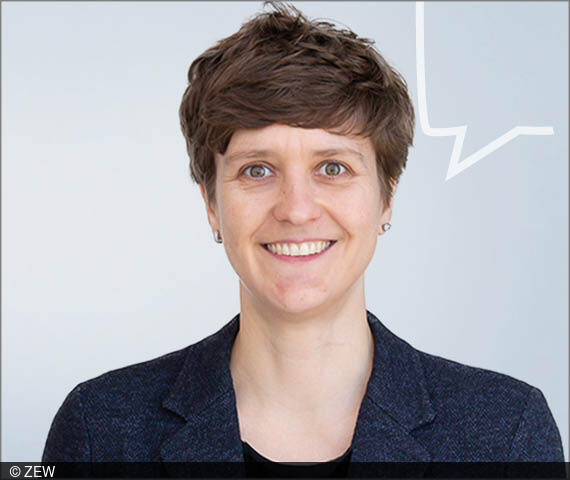Approval procedures for on-shore wind energy plants are slow and costly
Questions & AnswersInterview with ZEW Economist Marion Ott
By 2030, renewable energy is to cover 65 percent of German energy supply. This is why the German Federal Government is planning to invite tenders for new public funds. In the past, competition for wind energy plant support was low, however. For the state, a lack of competition drives up the costs for renewable energy expansion, because it allows companies to place higher-priced bids.
This issue is at the heart of Dr Marion Ott’s work in the ZEW Research Group “Market Design”. In our interview, she explains how public fund auctions work and why competition is low.
How do auctions of public funds in the renewable energy sector work?
Several times a year, the Federal Network Agency invites tenders for public funds in order to support a given (megawatt) capacity in solar, wind or biomass plants. Energy companies that seek to build a plant will place a bid in the appropriate auction. They put forward developed projects for which the necessary approvals have already been obtained. In their bids, companies indicate the respective plant capacity as well as their requested support in cent per kilowatt hour. The latter part of their bid is capped by a maximum bid. During the auction, bids are ranked according to the amount of support requested. One by one, the lowest bids will win the auction until the capacity put out to tender is met. Each winning bid entails 20 years of support for each kilowatt hour of energy produced by the corresponding plant. In most auctions, the bid per kilowatt hour of energy produced determines a minimum sales price. In some cases, however, it sets a fixed premium on the energy market price.
Why does competition play such a key role in auctions?
Auctions were introduced in order to better adapt support to the production costs of renewables. Producing companies are better positioned to estimate their costs than agencies. Before support was allocated via auctions, agencies needed to fix a support rate. In auctions, on the other hand, competition usually ensures that bids are cost-oriented, that the lowest bids will win the funds and that support costs decrease as production costs in the renewable energy sector do. In the absence of competition, however, each bid in an auction is a winning bid if the capacity offered remains below the threshold of capacity put out to tender. In these cases, it is ultimately once again the agencies which determine the support rate. This is the case for on-shore wind energy plants at the moment. We have seen several auctions now in which all bids won and in the most recent auctions all companies placed bids amounting to the maximum bid.
How come there are so few bids for the construction of wind energy plants?
Companies may only place a bid if they have pre-developed plants. That is, they need to indicate a location for their plant and produce the necessary approvals. Thanks to these requirements, the likelihood that supported plants are actually built increases. However, pre-development is costly. Particularly where on-shore wind plants are concerned, the approval process is complicated and lengthy, e.g. due to lawsuits or conflicts with flight navigation systems or the use of air space for military purposes. If the costs for pre-development are set to be high, participation in auctions will not pay off for companies with limited prospects of success. In addition, regulations on the minimum distance of plants from residential areas are restrictive. This makes the quest for locations even more difficult.
What should auctions ideally look like in order to promote wind energy expansion?
Generally, we welcome the fact that across Europe, support is increasingly allocated via auctions rather than via fixed support rates. Auctions serve to exploit competition in order to distribute support more efficiently and meet the expansion goal at the lowest possible costs. Auctions are unable to generate competition where companies are unable or unwilling to offer the amount of capacity put out to tender. In order to generate competition, the general conditions surrounding the auctions need to be improved. Pre-development costs should not be unnecessarily high and should be cut, including by political means, in order to incentivise participation in auctions. Approval procedures need to become simpler, faster and less risky. Moreover, more land should be provided for the expansion of on-shore wind energy plants.
The German Federal Government is considering the exclusion of the most expensive projects from support if competition is too low. What are the effects provoked by such a measure?
For some time now, there has been the idea, discussed on a European level as well, to change the rules of the auctions for on-shore wind energy support: If the capacity offered falls short of the capacity put out to tender, the total capacity awarded support will be less than the amount initially put out to tender. Such a measure seeks to prevent that in case of low competition all companies place the maximum bid. Such auction rules were adopted for innovation tenders for combined plants, for example: Only bids amounting to 80 percent of the capacity put out to tender are awarded support if the auction is undersubscribed. A company which considers itself the weakest participant with the highest production costs, will see no chance of winning the auction. This is why such a company will shy away from shouldering the costly pre-development and hence from participating in the auction. Others will anticipate this, in turn consider themselves to be the weakest participant and refrain from taking part in the first place. This leads to a downward-spiralling of supply. In sum, such a regulation greatly reduces incentives for participating in auctions and further weakens competition.

